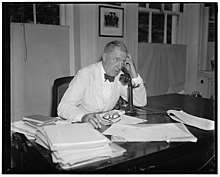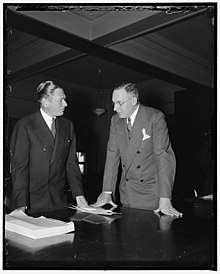Richard Whitney (financier)
Richard Whitney (August 1, 1888 – December 5, 1974) was an American financier, president of the New York Stock Exchange from 1930 to 1935. He was later convicted of embezzlement and imprisoned.
Richard Whitney | |
|---|---|
 Whitney, 1937 | |
| President of the New York Stock Exchange | |
| In office 1930–1935 | |
| Preceded by | Edward H. H. Simmons |
| Succeeded by | Charles R. Gay |
| Personal details | |
| Born | August 1, 1888 Boston, Massachusetts |
| Died | December 5, 1974 (aged 86) Far Hills, New Jersey, U.S. |
| Spouse(s) | Gertrude Sheldon Sands
( m. after 1916) |
| Children | 3 |
| Education | Groton School |
| Alma mater | Harvard University |
Early life
Whitney was born on August 1, 1888 in Boston, Massachusetts. He was a son of Elizabeth Whitney, a daughter of William M. Whitney, and George Whitney Sr. His father, a descendant of John Whitney,[1][2] was president of North National Union Bank.[3] His sister, Elinor Whitney, was married to Archibald Blanchard.
Richard and his older brother George Whitney Jr. (who later married Martha Beatrix Bacon, daughter of U.S. Secretary of State and Ambassador to France Robert Bacon) were educated at Groton School (where he was captain of the baseball team and school prefect) and Harvard University (where he was tapped for membership in the Porcellian Club).[4]
Career
_greets_Richard_Whitney_as_the_former_President_of_the_New_York_Stock_Exchange_returns_to_testify_before_the_LCCN2016871140.jpg)
In 1910, he followed his brother, George Whitney, Jr. to New York City where he established his own bond brokerage firm, Richard Whitney & Co. Two years later, using money borrowed from his family, Richard Whitney & Co. purchased a seat on the New York Stock Exchange. His uncle had been a partner in J.P. Morgan & Co., and brother George proved invaluable because of his position at the Morgan Bank which allowed him to direct substantial business to Richard's brokerage.
In 1919, he was elected to the Board of Governors of the New York Stock Exchange and not long thereafter was named its vice-president.
On October 24, 1929, Black Thursday, he attempted to avert the Wall Street Crash of 1929. Alarmed by rapidly falling stock prices, several leading Wall Street bankers met to find a solution to the panic and chaos on the trading floor of the New York Stock Exchange.[5] The meeting included Thomas W. Lamont, acting head of Morgan Bank; Albert Wiggin, head of the Chase National Bank; and Charles E. Mitchell, president of the National City Bank of New York. They chose Whitney, then vice president of the Exchange, to act on their behalf.[6]
With the bankers' financial resources behind him, Whitney went onto the floor of the Exchange and ostentatiously placed a bid to purchase a large block of shares in U.S. Steel at a price well above the current market. As traders watched, Whitney then placed similar bids on other "blue chip" stocks. This tactic was similar to a tactic that had ended the Panic of 1907, and succeeded in halting the slide that day. The Dow Jones Industrial Average recovered with a slight increase, closing with it down only 6.38 points for that day. In this case, however, the respite was only temporary; stocks subsequently collapsed catastrophically on Black Tuesday, October 29. Whitney's actions gained him the sobriquet, "White Knight of Wall Street."[7]
Downfall and prison sentence

At the same time that Richard Whitney was achieving great success, his brother George had also prospered at Morgan bank and by 1930 had been anointed as the likely successor to bank president, Thomas W. Lamont. While Richard Whitney was assumed to be a brilliant financier, he in fact had personally been involved with speculative investments in a variety of businesses and had sustained considerable losses. To stay afloat, he began borrowing heavily from his brother George as well as other wealthy friends, and after obtaining loans from as many people as he could, turned to embezzlement to cover his mounting business losses and maintain his extravagant lifestyle. He stole funds from the New York Stock Exchange Gratuity Fund, the New York Yacht Club (where he served as the Treasurer), and $800,000 worth of bonds from his father-in-law's estate.[8]
Having retired as president of the New York Stock Exchange in 1935, Whitney remained on the board of governors, but in early March 1938, his past began to catch up with him when the comptroller of the exchange reported to his superiors that he had established absolute proof that Richard Whitney was an embezzler and that his company was insolvent. Within days, events snowballed, and Whitney and his company would both declare bankruptcy. An astonished public learned of his misdeeds on March 10 when he was officially charged with embezzlement by New York County District Attorney Thomas E. Dewey. Following his indictment by a grand jury, Whitney was arrested and eventually pleaded guilty. He was sentenced to a term of five to ten years in Sing Sing prison.[9] On April 12, 1938, six thousand people turned up at Grand Central Terminal to watch as a scion of the Wall Street Establishment was escorted in handcuffs by armed guards onto a train that delivered him to prison.[10]
A model prisoner, Richard Whitney was released on parole in August 1941 after serving three years and four months in Sing Sing.[11] He became the manager of a dairy farm, supervising three farmhands and twenty-five cows. In 1946, he went back into business when he became president of a textile company that made yarns from the ramie plant, which grew in Florida.[12]
Personal life

In 1916, Whitney was married to Gertrude Alison (née Sheldon) Sands (1888–1969). Gertrude, a daughter of George R. Sheldon of Brooklyn, New York, was the widow of S.S. Sands & Co. banker Samuel Steven Sands III (a son of Anne Harriman Vanderbilt and step-son of William Kissam Vanderbilt), and from her first marriage. His father-in-law had served as president of the powerful Union League Club and Whitney became a member of a number of the city's elite social clubs and was appointed treasurer of the New York Yacht Club. In addition to her son from her first marriage, Samuel Stevens Sands IV (1911–1976), Richard and Gertrude were the parents of two daughters together:
- Nancy Whitney (1917–2012),[13][14] who married Henry Averell Gerry (1914–2000),[15] a son of Robert Livingston Gerry Sr. and brother of Elbridge T. Gerry Sr. and Robert L. Gerry Jr.[16][17]
- Alice Whitney (1919–2015), who married Screven Lorillard (1909–1979), a son of Ernest E. Lorillard and Elizabeth King (née Screven) Lorillard.[18] Lorillard was previously married to Natica Blair, a granddaughter of DeWitt Clinton Blair.[19]
Their New York City town home, New Jersey farm, and property were auctioned off.[20][21][22][23] After his fall from grace, his wife and family stood by him and friend May Kinnicutt and her husband, G. Hermann Kinnicutt, a partner in a stock brokerage firm, provided Mrs. Whitney with a farmhouse to live in at Far Hills, New Jersey. Whitney eventually made restitution for all the money his brother owed.[4]
Banned from dealing in securities for life, he was living a quiet life in Far Hills, New Jersey, at the time of his death on December 5, 1974.[4]
In popular culture
- The story of Richard Whitney on Wall Street was recounted in detail in a film by German director August Everding in 1966,[24] and by John Brooks as part of his 1969 book Once in Golconda : A True Drama of Wall Street 1920-1938 (ISBN 0-471-35753-7).
- Louis Auchincloss wrote a novel based on his life entitled The Embezzler.[25]
- He is mentioned, not by name, in John O'Hara's short story "Graven Image."
- Malcolm MacKay cite's Whitney in his book ''Impeccable Connections: "The Rise and Fall of Richard Whitney"
- John Kenneth Galbraith cite's Whitney in his "The Great Crash 1929."
References
- Whitney, Henry Austin. A Brief Account of the Descendants of John and Elinor Whitney, of Watertown, Mass. Boston: H. W. Dutton and Son, 1857, pp. 3 – 4. 7, 17
- Anderson, Robert Charles. The Great Migration, Immigrants to New England, 1634-1635, Volume VII (T-Y). Boston: New England Historic Genealogical Society, 2011, pp. 366-72.
- B. Hormans, Jr. (ed.) The Bankers' Magazine and Statistical Register, (New York: I. Smith Hormans, Jul. 1874 -Jun. 1875, Vol 29, or Vol. 9, Series 3), p. 648.
- Krebs, Albin (6 December 1974). "Richard Whitney, 86, Dies; Headed Stock Exchange" (PDF). The New York Times. Retrieved 2 December 2019.
- The Great Depression, by Robert Goldston, pages 39-40
- Leonard, Jonathan Norton Leonard (1939). Three years down. Carrick & Evans.
- Beschloss, Michael (September 14, 2014). "The Upshot – From White Knight to Thief". New York Times. p. BU1. Retrieved February 10, 2018.
- TIMES, Special to THE NEW YORK (28 October 1938). "SEC GIVES TOTALS ON WHITNEY LOANS; Broker Borrowed $27,361,500 in About 4 Months in Effort to Stave Off Bankruptcy $6,471,000 WAS NOT REPAID Commission Ascribes Failure of Firm to Activities Other Than Its Normal Affairs Ability to Borrow Noted Assets Drained Away SEC GIVES TOTALS ON WHITNEY LOANS Withdrawals Are Noted Few Accounts With the Public Early Insolvency Charged Morgan Influence Felt" (PDF). The New York Times. Retrieved 2 December 2019.
- "Richard Whitney's Sentence" (PDF). The New York Times. 12 April 1938. Retrieved 2 December 2019.
- TIMES, Special to THE NEW YORK (15 April 1938). "SING SING INMATES IN AWE OF WHITNEY; Raise Caps in Deferential Greeting--One Sacrifices His Sheets to Broker ALL CALL HIM 'MISTER' New Prisoner Embarrassed by Homage--Lorenz Is Named Trustee for Company Lorenz Is Elected Trustee" (PDF). The New York Times. Retrieved 2 December 2019.
- "WHITNEY GOES FREE ON PAROLE AUG. 11; Ex-Head of Stock Exchange to Be Manager of Dairy Farm '100 Miles From Boston' GOOD RISK,' BOARD FINDS He Will Quit Sing Sing After Serving 3 Years, 4 Months for $214,000 Theft" (PDF). The New York Times. 9 July 1941. Retrieved 2 December 2019.
- Bandler, James; Burke, Doris (December 16, 2008). "70 years before Madoff, there was Whitney". CNN.
- "NANCY W. GERRY". The New York Times. September 30, 2012. Retrieved 28 February 2017.
- "In Memoriam: Nancy Whitney Gerry". FishersIsland.net. 26 September 2012. Retrieved 28 February 2017.
- "Paid Notice: Deaths – Gerry, Henry Averell". The New York Times. 4 December 2000. Retrieved 28 February 2017.
- "HENRY GERRY TO WED MISS NANCY WHITNEY; Their Engagement Announced by Mrs. Richard Whitney" (PDF). The New York Times. 29 March 1940. Retrieved 2 December 2019.
- World, Times Wide (4 May 1940). "MISS WHITNEY WED TO HENRY GERRY; Becomes the Bride of Harvard Alumnus in the Church of the Epiphany Here" (PDF). The New York Times. Retrieved 2 December 2019.
- "Alice Whitney Lorillard, 96, equestrian, of Bedminster". New Jersey Hills. October 6, 2015. Retrieved 2 December 2019.
- "Deaths: LORILLARD--Screven" (PDF). The New York Times. 6 May 1979. Retrieved 2 December 2019.
- "SUES OVER WHITNEY DEBT; Trust Company Seeks to Foreclose Mortgage on Town House" (PDF). The New York Times. 5 October 1938. Retrieved 2 December 2019.
- "WHITNEY HOME OFFERED; 73d Street House in Foreclosure Auction on Dec. 20" (PDF). The New York Times. 1 December 1938. Retrieved 2 December 2019.
- "WHITNEY HOME HERE IS SOLD AT AUCTION; Bank, Only Bidder, Gets House in E. 73d St. for $90,000" (PDF). The New York Times. 21 December 1938. Retrieved 2 December 2019.
- TIMES, Special to THE NEW YORK (25 June 1938). "LIVESTOCK SOLD AT WHITNEY FARMM; Richard's Racing and Hunting Stables and Prize Cattle Bring $13,451 for Creditors. Carnival Spirit at Sale Horses Bring Total of $4,500" (PDF). The New York Times. Retrieved 2 December 2019.
- IMDB: Der Schwarze Freitag
- "THE EMBEZZLER by Louis Auchincloss". Kirkus Reviews. February 7, 1965. Retrieved 2 December 2019.